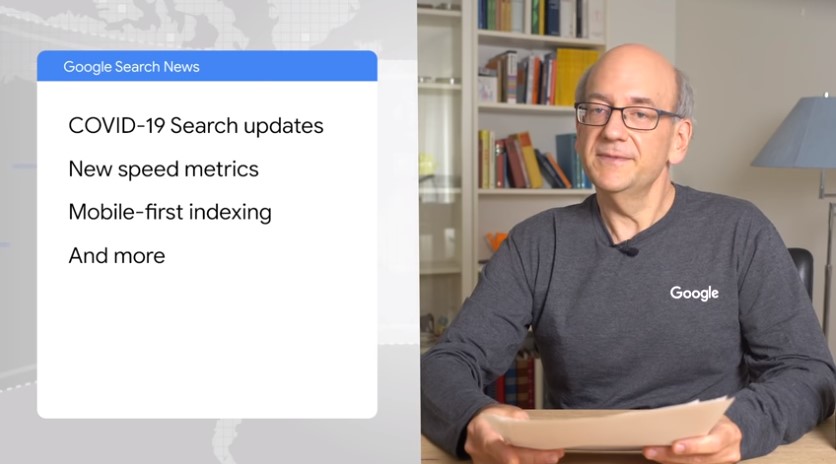Google Search News, May developments of the search engine
After skipping – almost unavoidably – the March appointment, back in a special and home edition is the Google Search News, the news video with which John Mueller summarizes the latest news and developments of the work done on the most used search engine in the world. So here are the topics of this episode dedicated to everything that happened in May 2020 (and not only).
Google Search news in May 2020
Renamed for the occasion “Google Search News – From Home”, the episode immediately denotes its particular character compared to the previous ones: it is set right in the house of John Mueller in Switzerland – literal host of the series! – that, like the other employees of Big G and many companies around the world, is in smart working mode as a result of the pandemic and everything that it has involved.
Despite the difficulties, Google still wants to provide a regular update by summarizing what is going on around the Search system, with information that can be especially useful to webmasters, publishers and SEOs.
What changed in the Google world
The last video of the series is dated in January – the Coronavirus has “upset everything”, making the activities more complicated and confusing, and also blew up the episode initially scheduled for March – and so this episode is particularly dense with news and information, with a summary that reads:
- Updates in Google Search related to Covid-19
- New metrics for speed
- Mobile-first indexing
and much more.
Coronavirus effect on Google
Many things have changed because of the Covid-19 and its worldwide spread; for Google, this meant adding and modifying certain parts of the search and helping webmasters to face new challenges in various ways.
For example, recalls Mueller, Google has introduced new structured data properties for virtual events, postponed or deleted, developed a guide with tips to pause your online business in a search friendly way (and not abandon or disable it!) and a digital marketing manual, offered technical support for health organizations and more (even in the making, anticipates the Googler).
The changes to the events also affected Google itself, leading to the decision to suspend all live activities scheduled until the end of the year: no Google I/O, no Webmaster Conferences and so on. To still support the community, though, the company has launched the Webmaster Conference Lightning Talks series, individual sessions dedicated to specific topics of the Research system.
Interventions on speed metrics
Much attention is then paid to the new Web Vitals metrics developed to measure more effectively and understandably the speed of pages on Chrome: the set of Core Web Vitals provides a clear set of basic metrics for each website, so as to help developers build and improve the online experiences of users.
The three metrics – for 2020 have been chosen the Largest Contentful Paint (LCP), First Input Delay (FID) and Cumulative Layout Shift (CLS) – will be introduced through a variety of tools, such as Lighthouse, Chrome Dev tools and Pagespeed insight.
- LCP measures the perceived loading speed and marks in a specific web page loading timeline the point where a main content of a page is likely to load. This metric depends on two other parameters, namely First Contentful Paint and Time to first byte.
- FID measures responsiveness and quantifies the experience users – indeed – experience when trying to have a first interaction with the page.
- CLS measures visual stability and quantifies the sum of unforeseen events created to move the layout of the visible content of the page.
Now the Google Search Console already offers an experimental tool to measure the speed of the site, which highlights the metrics previously used by the various tools. The GSC speed report will be updated to reflect the new Web Vitals metrics, announces Mueller, so to help site owners identify opportunities to improve the user experience provided and create fantastic sites.
Latest developments of the mobile first indexing
Mobile first indexing is the process by which Google indexes the web using a crawler that behaves like a mobile device (a smartphone, to be precise) and corresponds to what users commonly see when browsing.
Currently, about 70 percent of all search results shown are from this indexing and Google expects this number to increase significantly when some of the largest websites will be ready to be moved. “It is an incredible result, only achieved thanks to a lot of work on websites that made them work well for mobile devices,” says Mueller, and “we will continue to go on with mobile first indexing as soon as our systems recognize that sites are ready”.
As a goal – the Senior Webmaster Trends Analyst again recalls – at the beginning of the year Google decided to complete the switch to the mobile first index by September 2020, but because of the impact of Coronavirus it is possible that this date will be postponed.
Other news in the Google ecosystem
Mueller then quickly sums up the other innovations concerning the services and products of the Big G ecosystem. For instance, in recent weeks, a changelog of the most important updates made to the documentation for the developers of Google Search has been published online, which helps to stay informed about the main changes.
It was also introduced a documentation on the metadata of the image licenses that appear in Google Images, useful for those who use these resources on the site (we also mentioned it while talking about the new icons and labels that appear for previews), and a guide to the use of Javascript for structured data.
Lastly, the Search Console now has an improved removals tool, the tool for temporary removal of Urls from the search engine, presents in more depth information about rich snippets of reviews and has revamped the Change of address tool.



